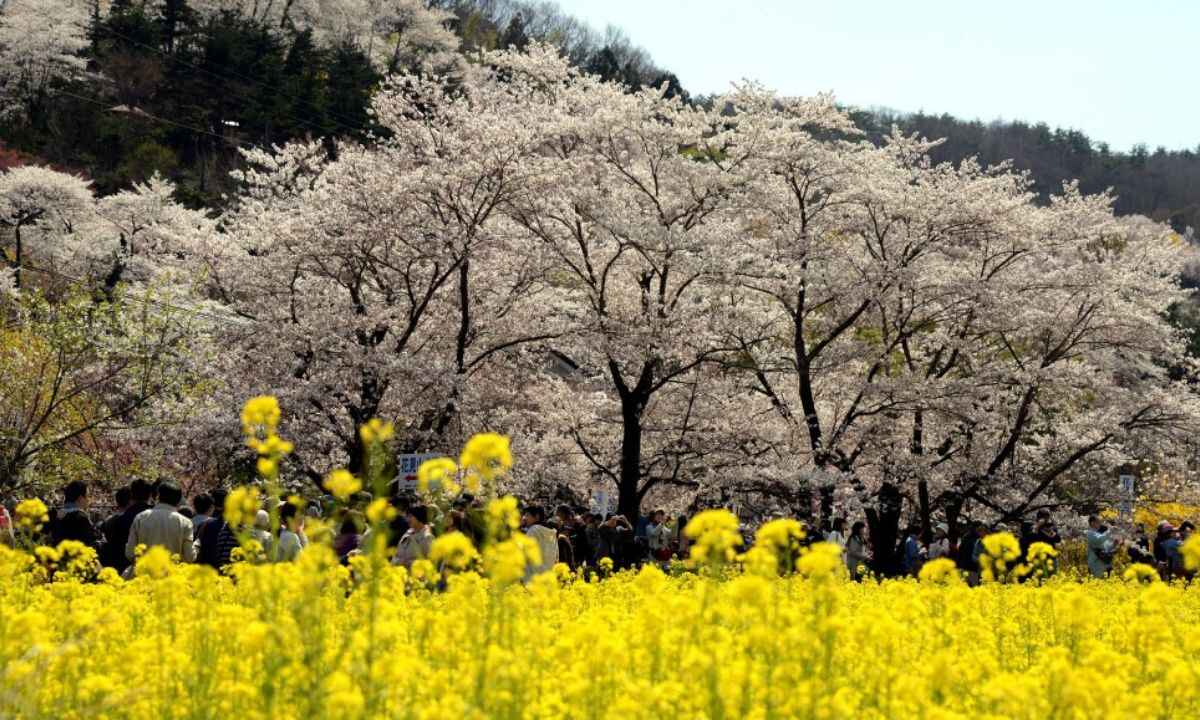Yellow Spring Road, located in Hirokawa, Japan, is a picturesque route renowned for its stunning floral displays and natural beauty. This 500-meter stretch transforms throughout the year, offering a kaleidoscope of colors and scents. In spring, it becomes a cherry blossom tunnel, creating a magical pink canopy.
Summer brings lush greenery, while autumn paints the landscape in vibrant hues. The road’s accessibility and well-maintained surroundings make it a perfect destination for nature lovers, photographers, and those seeking a tranquil escape from urban life.
Where is Yellow Spring Road?
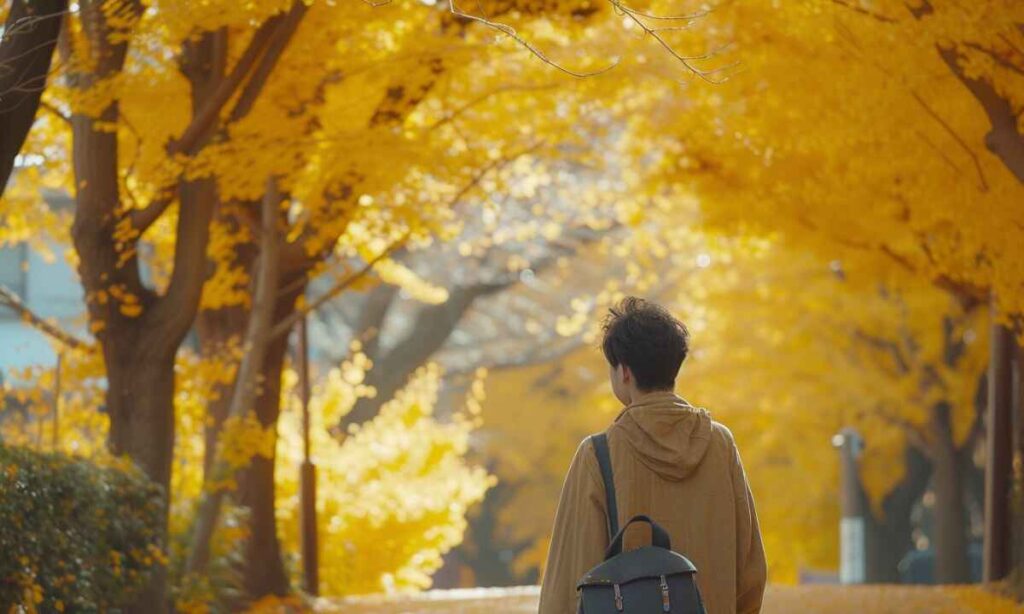
Yellow Spring Road is tucked away in the charming town of Hirokawa, Japan, located in the southwestern part of the country. This quaint locality, known for its picturesque landscapes and tranquil atmosphere, provides the perfect backdrop for Yellow Spring Road’s natural wonders. The road itself stretches for about 500 meters, offering an accessible yet immersive experience into Japan’s rural beauty.
Hirokawa’s topography is characterized by gently rolling hills and fertile valleys, creating a diverse landscape that Yellow Spring Road traverses. The area surrounding the road is a patchwork of rice paddies, tea plantations, and lush forests, each contributing to the road’s ever-changing scenery.
This variety of terrain not only enhances the visual appeal but also supports a rich ecosystem, making Yellow Spring Road a haven for nature enthusiasts and photographers alike.
What sets Yellow Spring Road apart is its meticulous maintenance and the care taken to preserve its natural beauty. The local community takes great pride in keeping the area pristine, ensuring that visitors can enjoy unobstructed views and clean surroundings.
This commitment to conservation allows Yellow Spring Road to maintain its charm year-round, inviting travelers to experience the unspoiled beauty of rural Japan.
Best Times to Visit Yellow Spring Road
Yellow Spring Road is a year-round destination, with each season offering its own unique charm. However, certain times of the year are particularly magical, drawing visitors from far and wide to witness nature’s spectacular displays.
Spring (March to May): This is perhaps the most popular time to visit Yellow Spring Road, thanks to the world-famous cherry blossom season. From late March to early April, the road transforms into a tunnel of delicate pink sakura blossoms, creating a breathtaking scene that epitomizes the beauty of Japanese spring. This period is ideal for hanami (flower viewing) picnics and photography.
Summer (June to August): While temperatures rise, Yellow Spring Road offers a cool retreat under the lush canopy of fully leafed trees. The vibrant greens of summer create a refreshing atmosphere, perfect for nature walks and outdoor activities. The Natsu Matsuri (Summer Festival) brings additional excitement to the area during this season.
Autumn (September to November): As temperatures cool, Yellow Spring Road bursts into a riot of reds, oranges, and golds. The autumn foliage attracts leaf-peepers from across Japan and beyond, making it a close second to spring in popularity. The Momiji Matsuri (Autumn Leaves Festival) celebrates this colorful spectacle.
Winter (December to February): Though less busy, winter offers a serene beauty to Yellow Spring Road. Occasional snowfall can transform the landscape into a winter wonderland, while clear days provide crisp views of the surrounding mountains. The Shogatsu Matsuri (New Year’s Festival) brings warmth and celebration to the cold season.
| Season | Highlights | Events | Weather |
| Spring | Cherry blossoms | Hanami Matsuri | Mild, occasional rain |
| Summer | Lush greenery | Natsu Matsuri | Warm to hot, humid |
| Autumn | Vibrant foliage | Momiji Matsuri | Cool, crisp |
| Winter | Serene landscapes | Shogatsu Matsuri | Cold, occasional snow |
Things to Do Around Yellow Spring Road
1. Cherry Blossom Viewing
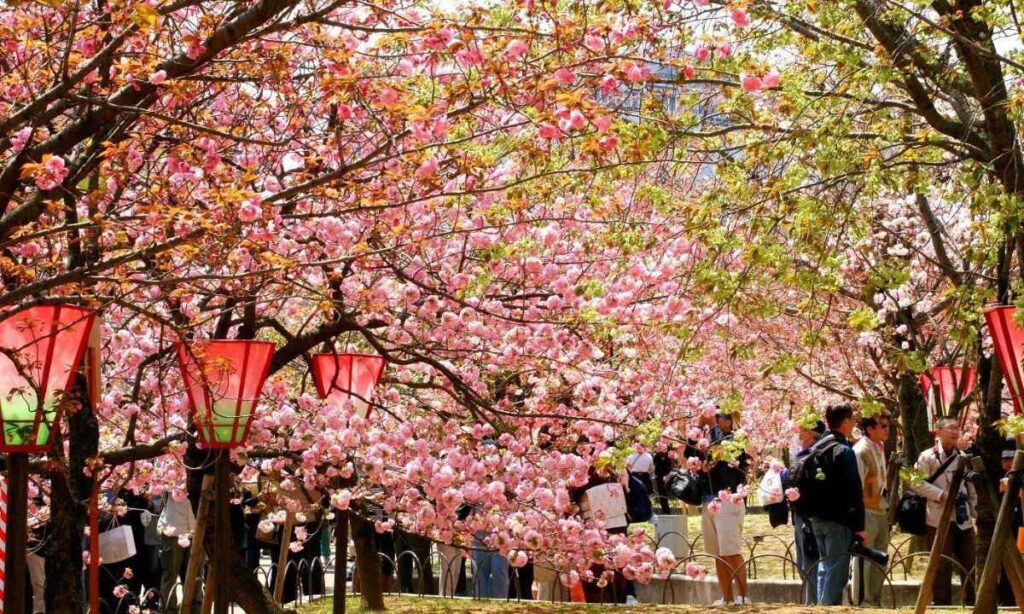
The cherry blossom season along Yellow Spring Road is nothing short of magical. As spring unfurls its gentle warmth across Hirokawa, the road becomes a pink canopy of delicate sakura blooms, creating a scene straight out of a Japanese fairytale. This natural spectacle, lasting only a few precious weeks, draws visitors from around the world to partake in the age-old tradition of hanami.
Hanami, literally meaning “flower viewing,” is more than just admiring the blossoms—it’s a celebration of life, renewal, and the ephemeral beauty of nature.
Along Yellow Spring Road, you’ll find locals and tourists alike spread out on blankets beneath the cherry trees, sharing food, drink, and laughter as petals flutter down like snow.
Tips for Visitors
To make the most of your cherry blossom viewing experience on Yellow Spring Road, consider these insider tips:
- Timing is everything: The bloom typically occurs in late March to early April, but can vary slightly each year. Check local forecasts for peak bloom predictions.
- Early bird gets the worm: Arrive early in the morning to secure a prime spot for your hanami picnic. The soft morning light is also ideal for photography.
- Pack a picnic: Bring a bento box filled with Japanese delicacies, or stop by local shops for seasonal treats. Don’t forget a blanket to sit on!
- Respect nature: While enjoying the blossoms, remember to leave no trace. Avoid damaging the trees or picking the flowers.
- Capture memories responsibly: While photography is encouraged, be mindful of others and avoid using drones or obstructing pathways.
Read Also These: Moto X3M Unblocked: The Ultimate Guide to Fun and Free Gameplay
2. Hiking and Nature Walks

Yellow Spring Road serves as a gateway to some of Hirokawa’s most picturesque trails, offering hikers and nature enthusiasts a chance to immerse themselves in the area’s stunning natural beauty. From leisurely strolls to more challenging hikes, there’s a path for every level of adventurer.
What to Expect
As you venture off Yellow Spring Road onto the surrounding trails, you’ll be greeted by a diverse landscape that changes with each season. Dense forests give way to open meadows, while babbling streams and hidden waterfalls provide serene pit stops along your journey. The area is home to a rich variety of flora and fauna, making it a paradise for nature lovers and birdwatchers.
Popular Hiking and Walking Routes
- Cherry Blossom Trail: A gentle 2-kilometer loop that’s particularly stunning during sakura season. This trail offers numerous vantage points for admiring the blossoms along Yellow Spring Road.
- Autumn Foliage Path: A moderate 5-kilometer hike that showcases the best of Hirokawa’s fall colors. The trail winds through maple groves and offers panoramic views of the surrounding countryside.
- Hirokawa Ridge Walk: For more experienced hikers, this 8-kilometer trail offers challenging terrain and rewarding vistas. On clear days, you can see all the way to the distant mountains.
Tips for Hikers and Walkers
- Wear appropriate footwear: Trails can be uneven or muddy, especially after rain. Sturdy hiking boots are recommended.
- Stay hydrated: Bring plenty of water, especially during summer months.
- Check weather forecasts: Conditions can change quickly, so be prepared with layers and rain gear.
- Inform others: Let someone know your hiking plans, especially if tackling longer trails.
Nearby Amenities
Along Yellow Spring Road and the nearby trails, you’ll find various amenities to enhance your hiking experience:
- Rest areas: Benches and picnic spots are scattered along the routes, offering places to rest and enjoy the scenery.
- Information kiosks: These provide maps, trail information, and local wildlife guides.
- Vending machines: Some popular trailheads have vending machines for quick refreshments.
3. Photography

Yellow Spring Road is a photographer’s dream, offering a constantly changing canvas of natural beauty throughout the year.
Whether you’re a professional with high-end gear or an amateur with a smartphone, the road provides endless opportunities to capture stunning images.
Scenic Beauty
The picturesque landscapes along Yellow Spring Road offer a variety of subjects for photographers. From the delicate pink hues of cherry blossoms in spring to the fiery reds and golds of autumn foliage, each season paints the road in a different light.
The interplay of light and shadow as sunbeams filter through the leafy canopy creates magical effects that photographers can capture at different times of the day.
Key Photography Spots
- Cherry Blossom Tunnel: During sakura season, the road transforms into a tunnel of pink blossoms. The best shots are often captured in the early morning or late afternoon when the light is soft.
- Autumn Reflection Pool: A small pond near the road offers perfect reflections of the colorful fall foliage. This spot is particularly photogenic on still days.
- Winter Frost Vista: On cold winter mornings, frost-covered branches create a magical scene. The area near the old stone bridge is especially picturesque.
- Summer Firefly Grove: For night photography enthusiasts, the nearby grove comes alive with fireflies in early summer, offering unique long-exposure opportunities.
Tips for Capturing the Best Photos
- Golden Hours: The hour after sunrise and before sunset offers the most flattering light for landscape photography.
- Use a Tripod: For sharper images, especially in low light conditions or for long exposures.
- Experiment with Perspectives: Get low to the ground for unique angles of flowers, or climb to higher vantage points for sweeping vistas.
- Capture Details: Don’t forget to zoom in on the little things – dewdrops on petals, interesting bark textures, or local wildlife.
Respecting the Environment
While capturing the beauty of Yellow Spring Road, it’s crucial to practice responsible photography:
- Stay on designated paths to avoid damaging vegetation.
- Do not disturb wildlife for the sake of a photo.
- Be mindful of other visitors and avoid blocking pathways with photography equipment.
- If photographing during festivals or events, always ask for permission before taking pictures of individuals.
4. Local Tea Houses and Eateries
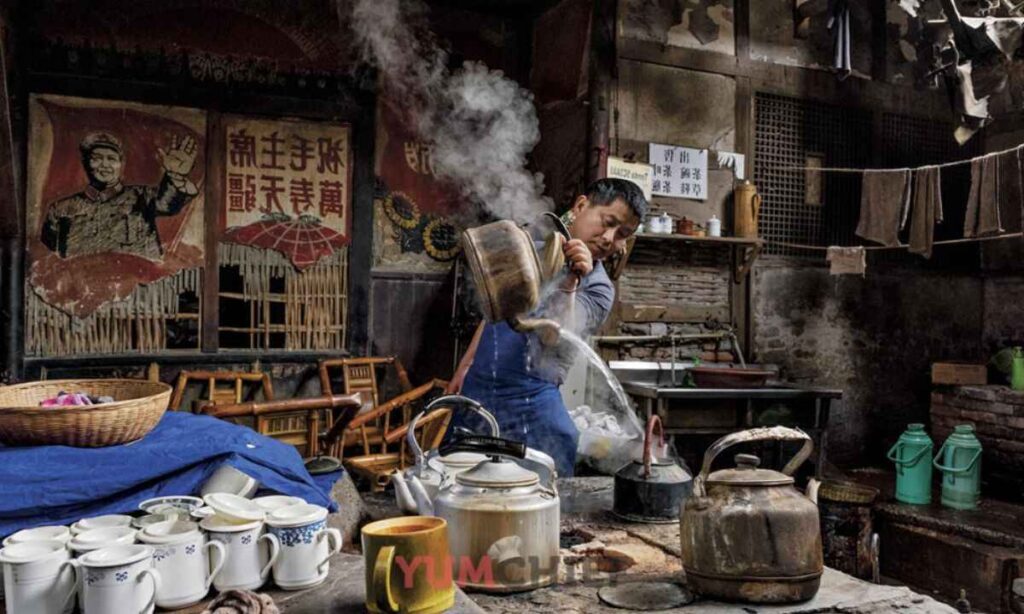
No visit to Yellow Spring Road would be complete without indulging in the local culinary scene. The area around the road is dotted with charming tea houses and eateries that offer a taste of traditional Japanese cuisine and culture.
Local Tea Houses
Hirokawa is renowned for its tea production, and the tea houses near Yellow Spring Road offer an authentic glimpse into Japan’s tea culture. Many of these establishments have been family-run for generations, preserving time-honored traditions and techniques.
- Traditional Atmosphere: Step into a world of tranquility as you enter these tea houses. Many feature traditional tatami mat seating, low tables, and beautiful garden views.
- Tea Varieties: Sample the local specialty, Yamecha, a green tea known for its rich umami flavor. Many tea houses also offer a variety of other teas, from sencha to hojicha.
- Tea Ceremony: Some tea houses offer the chance to participate in a traditional chado (tea ceremony), providing insight into this important aspect of Japanese culture.
One notable establishment is the Yamecha Wholesaler Shigematsu Kakujuen, where visitors can learn about tea production and sample various grades of local tea.
Local Eateries
The culinary landscape around Yellow Spring Road is a reflection of Hirokawa’s agricultural bounty and traditional cooking methods.
Local eateries serve up a range of dishes that change with the seasons, ensuring fresh, flavorful meals year-round.
- Seasonal Specialties: Spring brings dishes featuring tender bamboo shoots and fragrant cherry blossom-flavored sweets. Summer offers cool somen noodles and grilled ayu fish. Autumn heralds hearty mushroom dishes and chestnut-based desserts, while winter warms with hot pot dishes and seasonal citrus.
- Local Ingredients: Many restaurants pride themselves on using locally-sourced ingredients, from fresh vegetables grown in nearby farms to locally-caught fish.
- Traditional Dishes: Don’t miss trying local specialties like tempura made with seasonal vegetables, hearty udon noodles in rich broth, or delicate soba noodles served either hot or cold.
Dining Experience
Dining near Yellow Spring Road is about more than just the food—it’s an immersive cultural experience.
- Outdoor Seating: Some eateries offer outdoor seating with views of Yellow Spring Road, allowing you to enjoy your meal amidst nature’s beauty.
- Kaiseki Cuisine: For a truly special experience, look for restaurants offering kaiseki—a multi-course meal that showcases the chef’s skill and seasonal ingredients.
- Farm-to-Table: Several establishments offer farm-to-table experiences, where you can pick your own vegetables and have them prepared for your meal.
Tips for Visitors
- Reservations: Popular tea houses and restaurants can get busy, especially during peak seasons. Consider making reservations in advance.
- Etiquette: Remember to remove your shoes when entering traditional establishments. Use the provided oshibori (wet towel) to clean your hands before eating.
- Dietary Restrictions: While vegetarian options are becoming more common, it’s best to inform the staff of any dietary restrictions in advance.
- Payment: Some smaller establishments may only accept cash, so it’s good to have some on hand.
5. Cultural Experiences
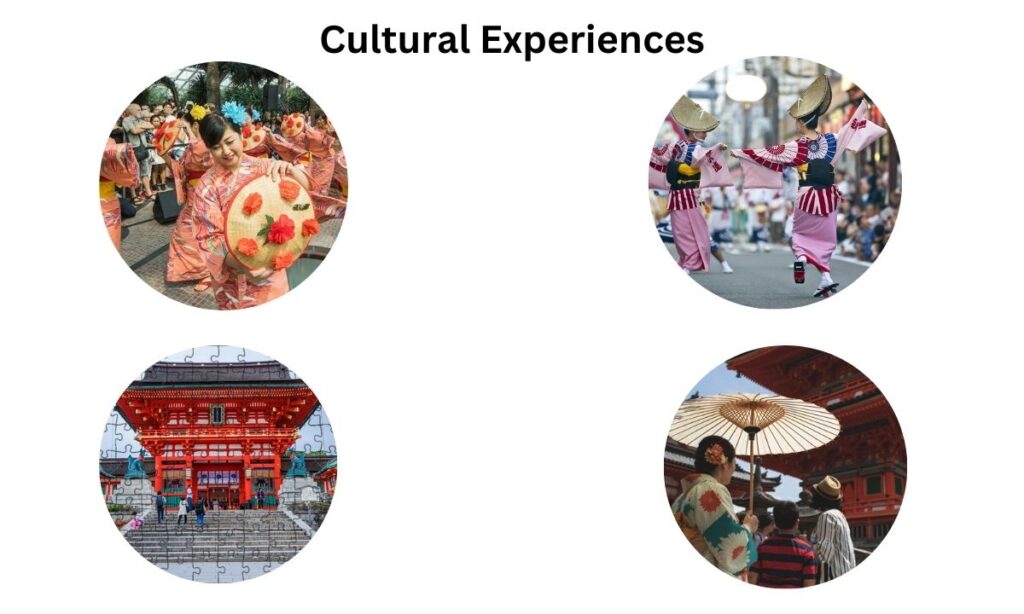
Yellow Spring Road isn’t just about natural beauty—it’s a gateway to rich cultural experiences that offer insights into traditional Japanese life. From ancient rituals to hands-on crafts, the area provides numerous opportunities to immerse yourself in local customs and traditions.
Traditional Tea Ceremonies
One of the most refined expressions of Japanese culture is the tea ceremony, known as chado or sado. Near Yellow Spring Road, you can participate in this ancient ritual, which is as much about spiritual discipline and aesthetics as it is about enjoying tea.
- Ceremony Process: A full tea ceremony can last up to four hours and involves specific movements, utensils, and etiquette. Shorter versions are available for tourists.
- Matcha Preparation: Watch as the tea master skillfully prepares matcha, a finely ground green tea, whisking it into a frothy brew.
- Seasonal Elements: The ceremony often incorporates seasonal elements, from the sweets served to the flower arrangement in the alcove.
Participating in a tea ceremony offers a moment of tranquility and a deeper appreciation for the Japanese concept of mindfulness and harmony with nature.
Local Festivals and Events
Throughout the year, Yellow Spring Road and the surrounding Hirokawa area come alive with vibrant festivals that celebrate the changing seasons and local traditions. These events offer visitors a chance to experience the heart of Japanese culture and community spirit.
1. Cherry Blossom Festival (Hanami Matsuri)
Timing: Late March to early April
The Hanami Matsuri is the crown jewel of Hirokawa’s festival calendar, celebrating the ephemeral beauty of cherry blossoms along Yellow Spring Road. This festival transforms the already picturesque road into a wonderland of pink petals and joyous celebration.
- Illuminated Night Viewing: The cherry trees are lit up in the evenings, creating a magical atmosphere for nighttime hanami.
- Traditional Performances: Enjoy taiko drumming performances and classical Japanese dance shows set against the backdrop of blooming cherry trees.
- Food Stalls: Sample seasonal treats like sakura mochi and hanami dango from local vendors.
- Picnicking: Join locals in the time-honored tradition of picnicking beneath the cherry blossoms.
2. Autumn Leaves Festival (Momiji Matsuri)
Timing: Late October to early November
As the leaves along Yellow Spring Road turn to brilliant shades of red and gold, Hirokawa celebrates with the Momiji Matsuri. This festival honors the beauty of autumn and the bounty of the harvest season.
- Foliage Tours: Guided walks along Yellow Spring Road and surrounding trails showcase the best spots for autumn colors.
- Art Exhibitions: Local artists display works inspired by the fall scenery.
- Harvest Market: Sample and purchase local produce and crafts at the special autumn market.
- Outdoor Concerts: Enjoy music performances set against the backdrop of colorful foliage.
3. Summer Festival (Natsu Matsuri)
Timing: Mid-July to August
The Natsu Matsuri brings a lively atmosphere to Yellow Spring Road and Hirokawa during the hot summer months. This festival is a celebration of community and traditional summer pastimes.
- Bon Odori: Join in the traditional bon odori dance, performed in a large circle to the rhythm of taiko drums and folk songs.
- Yukata Wearing: Many attendees dress in light summer kimonos called yukatas, adding to the festive atmosphere.
- Fireworks Display: The highlight of the festival is often a spectacular fireworks show over Yellow Spring Road.
- Game Stalls: Try your hand at traditional festival games like goldfish scooping and ring tossing.
4. Hirokawa Harvest Festival
Timing: Late September
The Hirokawa Harvest Festival celebrates the agricultural heritage of the region, with Yellow Spring Road serving as a central point for festivities. This event showcases the bounty of local farms and the traditional farming practices that have shaped the landscape.
- Rice Harvesting Demonstrations: Watch or even participate in traditional rice harvesting techniques.
- Local Produce Market: Sample and purchase a wide variety of fresh, locally-grown fruits and vegetables.
- Cooking Demonstrations: Local chefs showcase how to prepare seasonal dishes using harvest ingredients.
- Traditional Craft Workshops: Learn about crafts related to farming and rural life, such as straw weaving or indigo dyeing.
5. New Year’s Festival (Shogatsu Matsuri)
Timing: December 31st to January 3rd
The Shogatsu Matsuri brings a touch of magic to Yellow Spring Road during the winter months. This festival combines ancient traditions with modern celebrations to welcome the new year.
- Hatsumode: Join locals in their first shrine visit of the year, often to nearby temples along Yellow Spring Road.
- Bell Ringing Ceremony: Participate in the tradition of ringing temple bells 108 times to cleanse the past year’s sins.
- New Year’s Food: Enjoy traditional osechi ryori, specially prepared dishes eaten during the New Year celebrations.
- Mochi Making: Watch or participate in mochi-making demonstrations, a beloved New Year’s tradition.
Tips for Enjoying Hirokawa Festivals

To make the most of your festival experience along Yellow Spring Road, keep these tips in mind:
- Dress Appropriately: For summer festivals, consider renting or purchasing a yukata for an authentic experience. In cooler months, layers are key as temperatures can drop in the evenings.
- Arrive Early: Popular festivals, especially the Cherry Blossom and Autumn Leaves festivals, can get crowded. Arriving early ensures you get good spots for viewing parades or performances.
- Try Local Delicacies: Festivals are the perfect time to sample seasonal specialties and street food. Don’t miss out on festival-only treats!
- Participate Respectfully: Join in activities like bon odori dancing or tea ceremonies, but be mindful of local customs and etiquette.
- Carry Cash: Many festival stalls and smaller vendors may not accept credit cards, so it’s wise to have cash on hand.
- Learn Key Phrases: Knowing a few basic Japanese phrases can enhance your experience and show respect to the local community.
Historical and Religious Sites
While Yellow Spring Road itself is a relatively modern attraction, the surrounding area is steeped in history and spiritual significance.
Exploring these sites offers a deeper understanding of the cultural fabric that makes this region so special.
- Hirokawa Shrine: Located just off Yellow Spring Road, this ancient Shinto shrine is believed to date back over 1,000 years. Its serene grounds offer a peaceful retreat and a glimpse into Japan’s indigenous faith.
- Zenryuji Temple: This Buddhist temple, famous for its autumn foliage, provides a tranquil space for meditation and reflection. Its traditional architecture and carefully manicured gardens make it a must-visit for history and culture enthusiasts.
- Old Samurai Residence: A short distance from Yellow Spring Road, you can explore a preserved samurai home, offering insights into the life of Japan’s warrior class during the Edo period.
- Hirokawa Folk Museum: This small but informative museum showcases the area’s agricultural heritage and traditional crafts, providing context to the rural landscapes you’ll see along Yellow Spring Road.
Traditional Crafts and Workshops
The area around Yellow Spring Road is known for preserving traditional Japanese crafts. Visitors can not only purchase unique handmade items but also participate in workshops to learn these age-old techniques.
- Pottery Making: Learn the basics of Japanese pottery, including the local style of glazing that reflects the colors of Yellow Spring Road’s changing seasons.
- Washi Paper Making: Create your own sheets of traditional Japanese paper, often decorated with pressed flowers or leaves from the area.
- Ikebana Classes: Try your hand at the art of Japanese flower arranging, using seasonal blooms found along Yellow Spring Road.
- Tea Ceremony Workshops: Delve deeper into the world of Japanese tea culture with hands-on lessons in the art of preparing and serving matcha.
Culinary Experiences
The culinary landscape around Yellow Spring Road is a reflection of Hirokawa’s rich agricultural heritage and Japan’s seasonal approach to cuisine.
- Cooking Classes: Learn to prepare local dishes using seasonal ingredients sourced from farms near Yellow Spring Road. Popular classes include making tempura, rolling sushi, and preparing traditional Japanese sweets.
- Tea Plantation Tours: Visit nearby tea plantations to learn about the cultivation and processing of green tea, including the prized local Yamecha.
- Sake Tasting: Discover the nuances of Japan’s national drink at local breweries, where you can learn about the sake-making process and sample various types.
- Seasonal Fruit Picking: Depending on the time of year, participate in fruit-picking activities at local orchards. Strawberries in spring, peaches in summer, and apples in autumn are particularly popular.
Local Markets and Shopping
No visit to Yellow Spring Road would be complete without exploring the local markets and shops that showcase the best of Hirokawa’s products and craftsmanship.
- Hirokawa Farmers Market: Held weekly, this market is the best place to find fresh, locally-grown produce and artisanal food products.
- Craft Fairs: Seasonal craft fairs along Yellow Spring Road feature handmade items from local artisans, including pottery, textiles, and woodwork.
- Tea Shops: Specialty tea shops offer a wide variety of local teas, including the famous Yamecha. Many shops allow tastings and provide expert advice on tea selection.
- Souvenir Shops: Find unique mementos of your visit, from traditional crafts to modern items inspired by the beauty of Yellow Spring Road.
Tips for Visitors
To ensure a memorable and respectful visit to Yellow Spring Road and Hirokawa, keep these final tips in mind:
- Respect Local Customs: Always be mindful of local traditions and etiquette, especially when visiting shrines or temples.
- Learn Basic Japanese: While many locals in the tourism industry speak some English, learning a few key phrases in Japanese can greatly enhance your experience.
- Be Mindful of Nature: Help preserve the beauty of Yellow Spring Road by not littering and staying on designated paths.
- Try Local Specialties: Don’t be afraid to step out of your culinary comfort zone and try local dishes – it’s part of the cultural experience!
- Plan According to Seasons: Each season offers a unique experience along Yellow Spring Road, so plan your visit based on what you’d like to see and do.
- Book in Advance: During peak seasons, especially cherry blossom time, accommodations can fill up quickly. Book well in advance to secure your preferred options.
By following these tips and immersing yourself in the local culture, your visit to Yellow Spring Road will be not just a trip, but a journey into the heart of traditional Japan.
Planning Your Visit to Yellow Spring Road
Planning your visit to Yellow Spring Road requires careful consideration of seasonal attractions, transportation options, and local activities. This guide will help you choose the best time to visit, navigate your way to Hirokawa, and make the most of your trip.
From cherry blossoms to autumn foliage, each season offers unique experiences. Consider local festivals, weather conditions, and your preferences when planning your journey to this picturesque destination in Japan.
Best Time to Visit
The best time to visit Yellow Spring Road depends on your preferences. Spring offers cherry blossoms, summer brings lush greenery, autumn showcases colorful foliage, and winter provides a serene atmosphere.
Consider local festivals and weather conditions when planning your trip. Each season has its charm, allowing for diverse experiences throughout the year.
Spring (March to May)
Spring is a popular time to visit Yellow Spring Road. The highlight is the cherry blossom season from late March to early April. The weather is mild, perfect for outdoor activities.
Don’t miss the Cherry Blossom Festival, featuring traditional performances and cultural events. This season offers stunning visuals and comfortable temperatures for exploring the area.
Summer (June to August)
Summer brings lush greenery to Yellow Spring Road. The countryside is vibrant, and forests are at their most verdant. Enjoy the Summer Festival (Natsu Matsuri) with traditional dances and fireworks.
Longer daylight hours are ideal for extended hiking and picnicking. However, be prepared for higher temperatures and occasional rain showers during this season.
Autumn (September to November)
Autumn transforms Yellow Spring Road with vibrant foliage. From October to November, the landscape becomes a canvas of red, orange, and yellow.
The Autumn Leaves Festival (Momiji Matsuri) celebrates this colorful season with nature walks and seasonal food. The weather is cool and comfortable, making it perfect for outdoor activities and photography.
Winter (December to February)
Winter brings a serene beauty to Yellow Spring Road. While colder, this season offers a peaceful atmosphere with fewer tourists. Experience the New Year’s Festival (Shogatsu Matsuri) with traditional celebrations.
Enjoy the tranquility of snow-dusted landscapes and the cozy ambiance of local tea houses. Winter is ideal for those seeking a quiet retreat.
How to Get to Hirokawa and Yellow Spring Road
Reaching Hirokawa and Yellow Spring Road is accessible through various transportation options. Fukuoka Airport serves as the nearest major air hub. From there, you can take trains, buses, or rent a car.
The journey from Fukuoka involves a combination of Shinkansen (bullet train) and local trains or buses. If driving, the Kyushu Expressway provides a direct route.
Each method offers different advantages in terms of speed, scenery, and flexibility, allowing you to choose based on your preferences and itinerary.
By Air
The nearest major airport is Fukuoka Airport, serving both domestic and international flights. From the airport, you can reach Hirokawa by taking a combination of trains or buses.
Consider renting a car at the airport for more flexibility. Flight options vary seasonally, so book in advance, especially during peak tourist seasons.
By Train
From Fukuoka, take the Shinkansen (bullet train) to Kurume Station, then transfer to a local train on the JR Kagoshima Main Line to Hirokawa Station.
From Tokyo, take the Shinkansen to Hakata Station in Fukuoka, then follow the same route. Train travel offers scenic views and is efficient for reaching Hirokawa.
By Bus
Express bus services run from Fukuoka to Hirokawa, taking about 1.5 to 2 hours. Alternatively, take a bus from Kurume Station after arriving by train.
Bus travel is often more economical and provides a chance to see the countryside. Check schedules in advance, as frequency may vary depending on the season.
By Car
Drive south on the Kyushu Expressway from Fukuoka and take the Hirokawa Exit. Follow local roads to reach Yellow Spring Road.
The drive takes about 1 to 1.5 hours. Renting a car provides flexibility to explore the area at your own pace. Be aware of parking options and local traffic rules.
Getting Around Hirokawa
Once in Hirokawa, use local buses and taxis to navigate the area. Many attractions, including Yellow Spring Road, are easily accessible by these means. For a more immersive experience, consider renting a bike or walking.
The scenic beauty of Hirokawa makes biking and walking enjoyable and memorable options for exploring the local area.
Why You Should Visit Yellow Spring Road
Yellow Spring Road is a hidden gem in Japan, offering a perfect blend of natural beauty and cultural experiences. It’s ideal for nature enthusiasts, photography lovers, and those seeking a peaceful retreat. The road’s seasonal transformations provide unique experiences year-round, from cherry blossoms in spring to vibrant foliage in autumn.
Local festivals, traditional tea houses, and nearby historical sites offer insights into Japanese culture. Yellow Spring Road provides an authentic, off-the-beaten-path experience that captures the essence of rural Japan.
More Post: How Old is Travis Kelce Daughter? (2024)
Final Words
Yellow Spring Road in Japan is a breathtaking flower paradise, famous for its vibrant seasonal blooms. Nestled amidst scenic landscapes, this road attracts visitors year-round, especially during spring when cherry blossoms and other flowers create a picturesque view.
The colorful surroundings, combined with tranquil nature, make it a must-visit for nature lovers, photographers, and tourists seeking a serene escape into Japan’s beautiful floral wonders.

SwaggerDiary.com is managed by an experienced team dedicated to delivering insightful articles, engaging content, and valuable resources across various topics.
